Change in Material Per Turn

This chart is based on a single playout, and gives a feel for the change in material over the course of a game.
Capture a majority of shooters
Move a neutral shooter (as a chess queen). After moving, that piece shoots a stone (belonging to the player) which permanently blocks the destination space. If a shooter is immobilised, it is captured by the largest adjacent group.
General comments:
Play: Combinatorial
Family: Combinatorial 2013
Mechanism(s): Capture,Movement
Components: Board
| BGG Entry | Veletas |
|---|---|
| BGG Rating | 7.11905 |
| #Voters | 21 |
| SD | 1.95122 |
| BGG Weight | 2.5 |
| #Voters | 2 |
| Year | 2013 |
| User | Rating | Comment |
|---|---|---|
| luigi87 | 9 | My game. Amazons turned inside out. |
| rseater | 4 | Played on the recommended 10x10, this is incredibly slow paced. The early game lacks direction. The mid-game is interesting as players maneuver to connect larger groups to score tokens, but it's too long in coming. The late game is computable. Not my kind of abstract. |
| mrraow | 8 | Clearly inspired by Amazons, but with a distinct feel. Individual moves don't seem critical, in the sense that there is usually more than one move that will meet your strategic objectives; yet at the same time, you can set strategic objectives, and aim to carry them out. There seems to be some crossover with go in terms of influence; probably as a result of the definition of a group, and sacrificing a piece for influence seems viable. Looking forward to playing again. |
| andres0804 | 8 | |
| arian | 7 | |
| Kaffedrake | 5 | Kind of like an inverted Amazons: barriers are no longer neutral, but the moving pieces are. Instead of enclosing space you are trying to project influence, or something. Probably a good game if you don't mind that it's less intuitive than Amazons and you may want to study some patterns: even games on large boards can locally become unforgivingly tactical at the drop of a hat. |
| clark94 | 9 | Amazons in reverse. Instead of player owned pieces and neutral stones as in Amazons, Veletas features neutral pieces and player owned stones. In Amazons players build walls to protect and isolate their amazons from their opponents. In Veletas shooters (mutually owned) become viciously self hunted , whoever can create the biggest "trap" around a shooter claims it. |
| orangeblood | 6 | An interesting Amazons-like game. Move one of seven “shooters” and fire a stone of your color. Once a shooter is trapped, whoever has the largest group orthogonal to it wins that point. That need to build up large groups is what made it interesting for me. It does have the feel of attempting to herd cats, though (one of my opponents said it "feels like knitting water”). |
| Talisinbear | N/A | Owning, reasonably we can likely all put a set together. Interesting concept, should be intriguing to explore. |
| clayhaus | 9 | A wonderful abstract strategy game that promises many hours of play. |
| raphaell7 | 7.5 | |
| Jugular | 8 | A very nice development of some of the concepts in Amazons. For me it's a viable alternative since the game feels complete once decided. I think there will be some nice tricks to explore but it still feels a little aimless in the very early stages. Possibly less so than Amazons. A good game and worthy of some exploration. |
| grasa_total | 7 | A sibling of Amazons, which I love. It seems to start a little faster than Amazons, which would mean a worse first-play experience when experience is unequal. But beyond the obvious inversion (here you own the arrows but share the archers, in Amazons it's the other way) I think there are more subtle reversals, like the fact that you try to garden and accumulate blocks of filled spaces here and empty spaces in Amazons; and while you want to preserve an archer's options in Amazons even when you're planning for her to frozen soon, here you want to constrain an archer as much as possible so that even with your opponent moving it, it might still be useful to you next turn. |
| Takvorian | 8 | |
| freechinanow | 7 | I very much enjoyed our game of Veletas. We played on a 7x7 board (instead of the standard 10x10) and the game moved at a nice pace, developed quickly, and never felt stale. There was some enjoyable spatial work that had to be done to figure out the best shooter to move and the best place to put a stone. And trying to get shooters out of jams or near-wins for the opponent provided quite a bit of tension. I also love a game that reduces the game space with each move, but still allows for a good amount of thinking right until the very end. As I'm looking at other Luis Bolaños Mures games (Ayu and Yodd in particular) I've come to see that I've not only discovered an excellent abstract but a thoughtful game designer in Bolaños Mures. |
| russ | 8 | Amazons turned inside out... :) We like playing it with red Looney pyramids + go stones. |
| Arcanio | 8 | |
| pulla | 5 | |
| Smjj | 1 | |
| jmastill | 9 | |
| nestorgames | 9 | |
| The Player of Games | 7 | Nice Amazons inspired abstract game. The objective is it immobilize a majority of the neutral shooters. Enjoyable, and with a distinct feel. However, I prefer Amazons so far. May increase in rating with further play. |
| AI | Strong Wins | Draws | Strong Losses | #Games | Strong Win% | p1 Win% | Game Length |
|---|---|---|---|---|---|---|---|
| Random | |||||||
| Grand Unified UCT(U1-T,rSel=s, secs=0.01) | 36 | 0 | 0 | 36 | 100.00 | 50.00 | 109.33 |
| Grand Unified UCT(U1-T,rSel=s, secs=0.03) | 36 | 0 | 9 | 45 | 80.00 | 57.78 | 112.67 |
| Grand Unified UCT(U1-T,rSel=s, secs=0.07) | 36 | 0 | 6 | 42 | 85.71 | 52.38 | 104.19 |
| Grand Unified UCT(U1-T,rSel=s, secs=0.20) | 36 | 0 | 10 | 46 | 78.26 | 67.39 | 99.52 |
| Grand Unified UCT(U1-T,rSel=s, secs=0.55) | 36 | 0 | 4 | 40 | 90.00 | 60.00 | 87.20 |
Level of Play: Strong beats Weak 60% of the time (lower bound with 90% confidence).
Draw%, p1 win% and game length may give some indication of trends as AI strength increases; but be aware that the AI can introduce bias due to horizon effects, poor heuristics, etc.
| Size (bytes) | 26511 |
|---|---|
| Reference Size | 10577 |
| Ratio | 2.51 |
Ai Ai calculates the size of the implementation, and compares it to the Ai Ai implementation of the simplest possible game (which just fills the board). Note that this estimate may include some graphics and heuristics code as well as the game logic. See the wikipedia entry for more details.
| Playouts per second | 8899.24 (112.37µs/playout) |
|---|---|
| Reference Size | 1329256.95 (0.75µs/playout) |
| Ratio (low is good) | 149.37 |
Tavener complexity: the heat generated by playing every possible instance of a game with a perfectly efficient programme. Since this is not possible to calculate, Ai Ai calculates the number of random playouts per second and compares it to the fastest non-trivial Ai Ai game (Connect 4). This ratio gives a practical indication of how complex the game is. Combine this with the computational state space, and you can get an idea of how strong the default (MCTS-based) AI will be.
| 1: White win % | 46.75±2.42 | Includes draws = 50% |
|---|---|---|
| 2: Black win % | 53.25±2.44 | Includes draws = 50% |
| Draw % | 0.00 | Percentage of games where all players draw. |
| Decisive % | 100.00 | Percentage of games with a single winner. |
| Samples | 1617 | Quantity of logged games played |
Note: that win/loss statistics may vary depending on thinking time (horizon effect, etc.), bad heuristics, bugs, and other factors, so should be taken with a pinch of salt. (Given perfect play, any game of pure skill will always end in the same result.)
Note: Ai Ai differentiates between states where all players draw or win or lose; this is mostly to support cooperative games.
Rotation (Half turn) lost each game as expected.
Reflection (X axis) lost each game as expected.
Reflection (Y axis) lost each game as expected.
Copy last move lost each game as expected.
Mirroring strategies attempt to copy the previous move. On first move, they will attempt to play in the centre. If neither of these are possible, they will pick a random move. Each entry represents a different form of copying; direct copy, reflection in either the X or Y axis, half-turn rotation.
| Game length | 103.43 | |
|---|---|---|
| Branching factor | 44.83 | |
| Complexity | 10^141.34 | Based on game length and branching factor |
| Computational Complexity | 10^7.23 | Sample quality (100 best): 32.98 |
| Samples | 1617 | Quantity of logged games played |
| Distinct actions | 6080 | Number of distinct moves (e.g. "e4") regardless of position in game tree |
|---|---|---|
| Good moves | 2635 | A good move is selected by the AI more than the average |
| Bad moves | 3445 | A bad move is selected by the AI less than the average |
| Terrible moves | 31 | A terrible move is never selected by the AI Terrible moves: c1->c10,b10->j2,j2-b10,j6->j1,f5->j1,c9->c1,j8->c1,d10-d1,h3->a10,e8->e1,b3->j3,f8->f1,j10->a1,i1->i10,h9-h1,a1->j10,i8->a8,h9->a9,e5->j5,e5->a1,i2-a2,i1->a9,j6-a6,b9-i9,e10->e1,a10->j1,d1-d10,e10->j10,a2->j2,i10->i1,j1->a10 |
| Samples | 1617 | Quantity of logged games played |

This chart is based on a single playout, and gives a feel for the change in material over the course of a game.

This chart shows the best move value with respect to the active player; the orange line represents the value of doing nothing (null move).
The lead changed on 32% of the game turns. Ai Ai found 13 critical turns (turns with only one good option).
Overall, this playout was 92.04% hot.

This chart shows the relative temperature of all moves each turn. Colour range: black (worst), red, orange(even), yellow, white(best).

Table: branching factor per turn.

This chart is based on a single playout, and gives a feel for the types of moves available over the course of a game.
Red: removal, Black: move, Blue: Add, Grey: pass, Purple: swap sides, Brown: other.
| 0 | 1 | 2 | 3 | 4 |
|---|---|---|---|---|
| 1 | 100 | 4708 | 134692 | 2649954 |
Note: most games do not take board rotation and reflection into consideration.
Multi-part turns could be treated as the same or different depth depending on the implementation.
Counts to depth N include all moves reachable at lower depths.
Inaccuracies may also exist due to hash collisions, but Ai Ai uses 64-bit hashes so these will be a very small fraction of a percentage point.
No solutions found to depth 4.
| Moves | Animation |
|---|---|
| d2,h4,c5 | 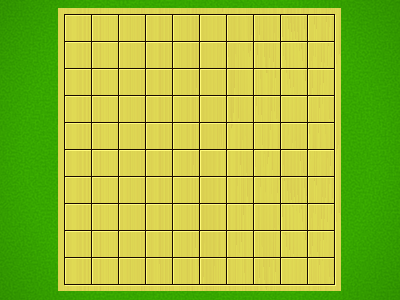 |
| d2,c5,h4 | 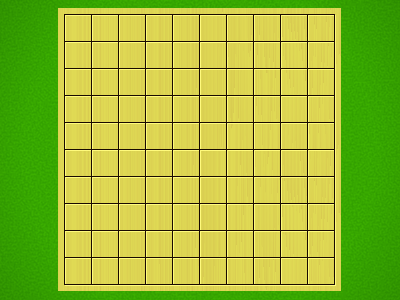 |
| h4,d2,c5 | 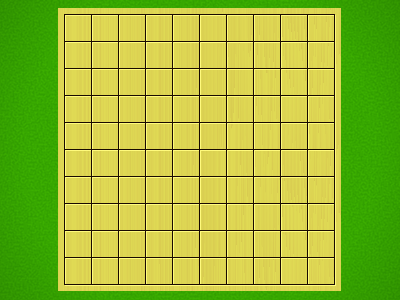 |
| c5,d2,h4 | 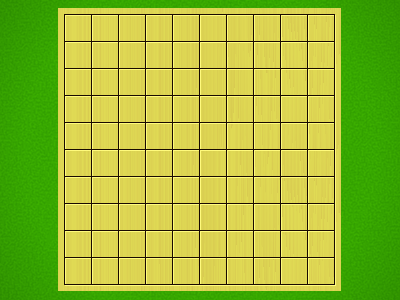 |
| b6,i10,d1 |  |
| h9,j9,d10 | 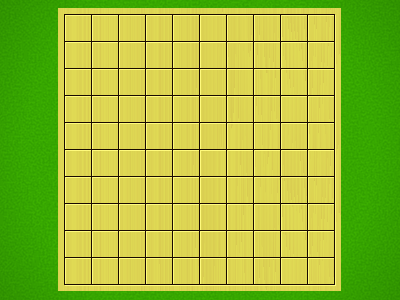 |
| j9,h9,d10 | 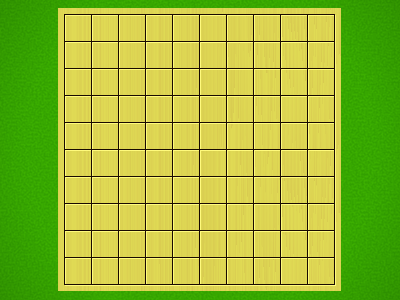 |
| i10,b6,d1 | 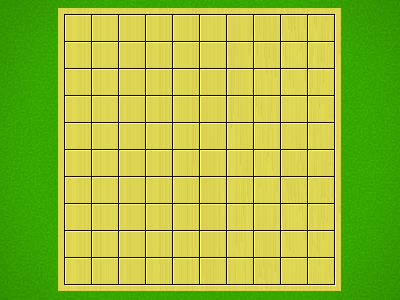 |
| i2,e9,e3 | 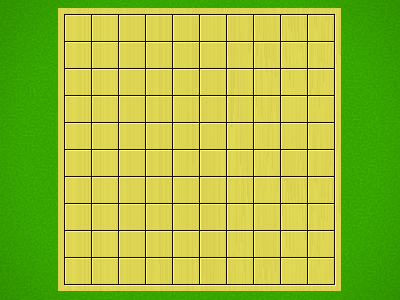 |
| b3,c9,f5 | 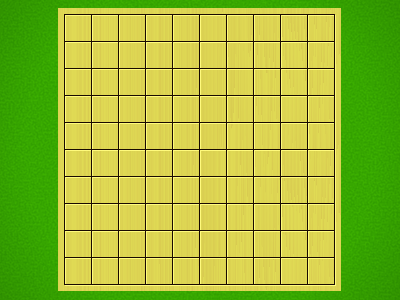 |
| e3,e9,i2 | 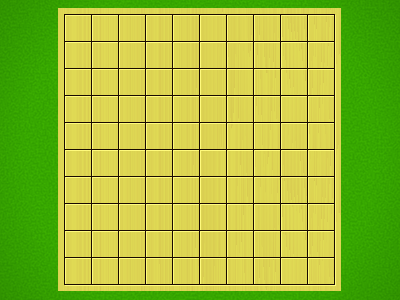 |
| f5,c9,b3 | 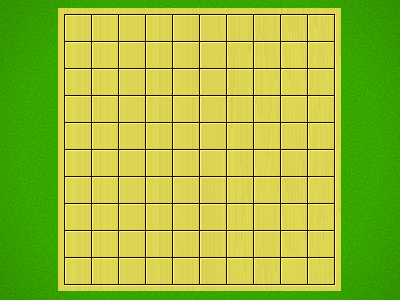 |
| Puzzle | Solution |
|---|---|
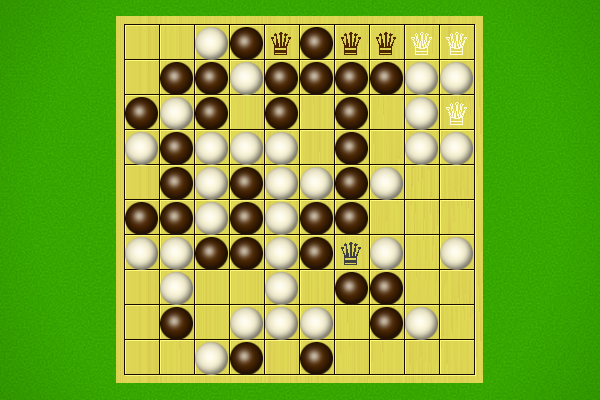 White to win in 20 moves |
Selection criteria: first move must be unique, and not forced to avoid losing. Beyond that, Puzzles will be rated by the product of [total move]/[best moves] at each step, and the best puzzles selected.